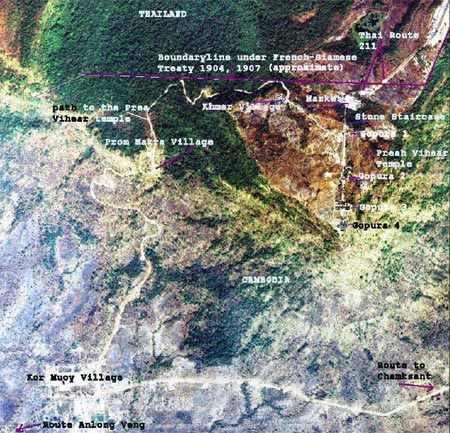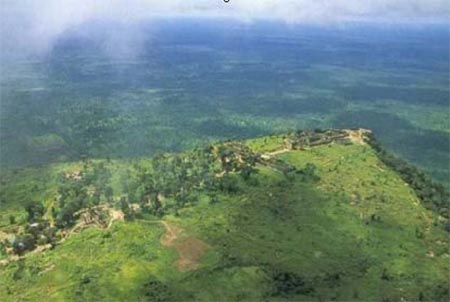Preah Vihear: A Khmer Heritage
http://www.cambodia.org/Preah_Vihear/?history=A+Khmer+Heritage
PREAH VIHEAR: A KHMER HERITAGE
By Kenneth T. So
THE KHMER EMPIRE
The Khmer Empire was at its apogee during the reign of Jayavarman VII (1181-1215 A.D.). Its territory covered the current Cambodia, all of southern Vietnam, all of the current Laos, all of the current Thailand, and part of the current Malaysia. Unlike the Khmers, Thais, known then as Siameses, were not natives of the region. The kingdom of Thailand, known then as Siam, did not appear in Southeast Asia until the mid- 14th century.
A well-known Thai historian, Sulak Sivarak, who was a Nobel Peace Prize nominee and the winner of the Right Livelihood Award said of the Khmer Empire: "It included everything right up to Lopburi and all of what is now Bangkok". Again, describing the Khmer Empire, Peter Janssan of the Hindustan Times quoted Sulak Sivaraka in his article on 18 June 2008: "Thai invasions of Cambodia, then in its decline, led to the adoption of many Khmer cultural traditions by the Thais, including the Hindu concept of god-kings and court rituals, and an ongoing fondness for Brahman-inspired black magic, especially among Thai politicians". Peter Janssan went on to describe that there are many more Khmer temples located in Thailand, especially along the northeast Thailand- Cambodian border like Buriram, Surin, and Sisaket. The map depicting the Khmer Empire at its height is shown in Figure 1.

Figure 1. Khmer Empire during the Height of its Civilization, Before the Appearance of Siam (From Jayavarman II to Jayavarman VII)
THE FRENCH PROTECTORATE
Cambodia was a vassal state under Siam during the reign of King Ang Duong. Cambodia had lost Battambang, Sisophon, and Siem Reap to Siam. Siam had placed spies everywhere at the court of Oudong. To get out of the Siam’s manacles, King Norodom who succeeded his father, King Ang Duong, sought out help from France. On 23 March 1907, under the reign of King Sisowath who succeeded his brother, King Norodom, France (as the protectorate of Cambodia) and Siam signed a border treaty that completed the 1904 treaty. In the 1904 treaty Siam ceded Tonlé Repou, Mlou Prey, Koh Kong, and Stung Trèng to Cambodia. The 1907 treaty subsequently produced the French- Siamese Commission 1907 Frontier Line (Figure 2), placing Preah Vihear under the control of Cambodia. The French-Siamese 1907 treaty had Siam ceded almost all Cambodia ancient territory of the 16th century back to Cambodia. The territory included Battambang, Sisophon, Siem Reap, Mongkol Borei, and Tnot (Figures 3 and 4).

Figure 2. Extract from the International Court of Justice Report 1962 – The French-Siamese Commission 1907 (Scale 1:200,000) (Courtesy Bora Touch. Note in blue added by Bora Touch for clarity)

Figure 3. Map of Cambodia Showing the Te rritory That Siam Ceded To France in 1907

Figure 4. Map of Present Day Cambodia Courtesy: Official Map by the Royal Government of Cambodia Submitted to UNESCO for Preah VihearWorld Heritage List
In spite of this agreement, Thailand contested in 1934 that the Temple of Preah Vihear belonged to her and their surveyors redrew the frontier to locate Preah Vihear in Thailand’s territory. In 1954 Thailand occupied Preah Vihear. On 6 October 1959, Cambodia, under the leadership of Prince Norodom Sihanouk, petitioned the International Court of Justice (ICJ) of the Hague, Netherlands, to rule on the dispute. By the end of the year, Thailand retaliated with a claim listing Preah Vihear as a national archeological site. On June 15, 1962, the ICJ made a judgment recognizing that the Temple of Preah Vihear belonged to Cambodia using the French-Siamese Commission 1907 Frontier Line as one of the supporting arguments (Figure 5). A satellite photo showing Preah Vihear and its surrounding region with demarcations of the frontier established by the French-Siamese Commission 1907 is presented in Figure 6. Figure 7 shows another satellite photo of Preah Vihear and the Dangrek mountain range. Thailand never protested against the verdict. However, over the years Thailand has unilaterally redrawn the map that contradicts the ICJ judgment (Figures 8- 10).

Figure 5. Area of the Temple of Preah Vihear in the Dangrek Range of Mountains (Extrapolation from the map recognized by the International Court of Justice, 15 June 1962) Courtesy: Official Map by the Royal Government of Cambodia submitted to UNESCO for Preah VihearWorld Heritage List

Figure 6. Satellite Photo of Preah Vihear and its Surrounding Region (Courtesy: Bora Touch)

Figure 7. Satellite Photo of Preah Vihear and its Surrounding Region (Courtesy: Bora Touch)

Figure 8. Thai Internal Working Document – The Official Thai Map (Scale 1:10,000) Courtesy Bora Touch. Notes in blue and green Colors added by Bora Touch for clarity

Figure 9. Thai Internal Working Document – The French-Siamese Commission Map Made in 1907 (Scale: 1:200,000) (Courtesy Bora Touch. Notes in blue by Bora Touch for clarity)

Figure 10. Extract from the Aide Memoire of Cambodia Royal Government 1962 (Scale: 1:6,000) (Courtesy Bora Touch. Note in blue by Bora Touch for Clarity)
The temple of Preah Vihear was originally built under Yasovarman I, a Khmer king who reigned from 889 to 910 A.D. The building started in light material, but its completion in stone was carried on later by his successors. The temple was dedicated to Shiva (God of destroyer).
The setting of Preah Vihear was ideal for a Khmer monarch who dedicated the temple for Shiva because of its spectacular location sitting atop of a high cliff over 500 meters above the lower ground. Aerial views of the Preah Vihear temples are shown in Figures 11 and 12.

Figure 11. Aerial View of Preah Vihear Hanging Over a Cliff On Cambodia Territory (Courtesy: Official Photo by the Royal Government of Cambodia Submitted to UNESCO for Preah VihearWorld Heritage List)

Figure 12. Aerial View of Preah Vihear
THE THAI TWISTED THESIS OF THEIR ORIGIN
There are some Thais in the academic, the press, and the media who fantasize in their justification of Preah Vihear belonging to Thailand by advancing a twisted thesis claiming that Khmer is not the same as Khorm (note: the Thai used to call Khmer as either Khamin or Khorm). They say that Khmer is Khamin, which is different from Khorm. Furthermore, they say that Khorms are the real inhabitants of what is now Thailand and they were the builders of Preah Vihear, Angkor, and all the ancient temples found in Cambodia and Thailand. They are saying that Khmers are not the descendents of the Angkor builders. Therefore, they try to justify by implication that Thai people are the true descendents of the Khorms, the original inhabitants of Thailand and builders of Preah Vihear and Angkor. The Thai people have such a twisted mind. Believing in this twisted thesis is like believing that a bullet firing from a gun can be curved around a corner. The Thais are not only satisfied to steal everything that are precious to Khmers and then claimed them to be their own, such as Preah Ko Preah Keo, Preah Khan Reach, Khmer classical dance and music, Khmer style boxing, and Khmer scripts “Aksor Moul” (the Thai called it sacred scripts instead of Khmer scripts), but now they try to even steal Khmer identity. They want to strip Khmer people bare of any ancestry.
OBSERVATIONS
A few important observations to the central issue of the Preah Vihear temple must be brought up to the attention of the world. The following are two immediate points of interest concerning the affair of the Preah Vihear temples:
- The press keeps mentioning that Preah Vihear was an ancient Hindu temple instead of a Khmer temple. Preah Vihear is not a Hindu temple but a Khmer temple built under the reign of Yasovarman I, a Khmer king in the 9th century, dedicated to Shiva, one of the Hindu gods. When the press says that Preah Vihear is a Hindu temple, it deemphasizes Khmer ownership and legitimacy to the temple. In modern time, the war of words is very important. This clarification is very important and it must be emphasized at all time.
- Thailand kept insisting on using her own map to claim the disputed area around Preah Vihear instead of the French-Siamese Commissioned Map of 1907, where the International Court of Justice (ICJ) based its judgment on to award Preah Vihear to Cambodia. The map was the product of the treaty signed by Thailand and French (Cambodia was under the French protectorate) in 1907. It is legal and binding. Thailand wants to use its own map that is not binding and not recognized by the International Court of Justice. Cambodia must not give in to the Thai insistence of using her own map to settle the dispute of Preah Vihear and its surrounding area.
CONCLUSION
Cambodia is doing the right thing to seek help from the United Nations (UN). It is not in the interest of Thailand to have the UN intervene in the affair of Preah Vihear, because she knows that Cambodia has more legitimacy and historical claim of Preah Vihear and its surrounding area than Thailand does. The UN will have to consider and abide by the 1962 judgment made by the International Court of Justice (ICJ) and the recent recognition by the United Nations Educational, Scientific, and Cultural Organization (UNESCO) that included Preah Vihear in the World Heritage List. If the UN were to side with Cambodia, then they would probably ask Thailand to withdraw from the disputed area.
Thailand is playing hardball because she knows Cambodia is no match with her militarily. Cambodia has no choice but to ask the UN for help. With the UN help Thailand will not dare to encroach further into Cambodia territory. If war were to erupt, Thailand would be condemned by the world and she will lose face. Additionally, the Muslims are now waiting for the right opportunity to stir troubles again in the southern region of Thailand if this latter decides to go to war with Cambodia. Thailand cannot afford to have war with Cambodia. Thailand may win in the short term but she will lose in the long run. Thailand fears the UN because among the five permanent members, Cambodia can count on France, China, and Russia to side with her. As to the US and the UK positions, nothing can be certain but if these two countries interpret the laws and historical facts properly, they should come to the conclusion that Thailand has no claim and basis over Preah Vihear and its surrounding area that she had ceded to Cambodia during the French-Siamese 1907 treaty.
The UN cannot ignore the ICJ judgment that recognized Preah Vihear belonging to Cambodia, because to do otherwise would bring chaos to the international rule of laws. There is no doubt, both based on the court of laws and historical facts, that the Temple of Preah Vihear is a Khmer heritage and belonging to Cambodia.
Labels: Preah Vihear

